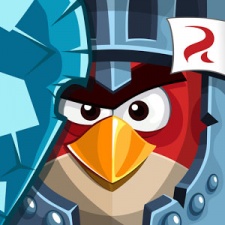Ellen Lyse Einarsen is project lead on Angry Birds Epic
Back in 2012, Munich-based developer Chimera Entertainment was working on a pitch for a casual RPG for mobile platforms.
It was called 100 Heroes, and contained everything a classic RPG needs; the classes, the potions, the special attacks - all combined with a more casual UI aimed at the mobile market, hoping to recruit a new cohort of players to this genre of games.
Founded in 2006 and headed by Remote Control Productions, Chimera Entertainment had launched several titles like Windchaser (2008), Warstory: Europe in Flames (2010) and Demolition Dash (2011), with moderate success.
And with their combination of contract work and own IPs, they were waiting for the real chartbuster. Little did they know that a flock of furious birds from Finland would be their gateway to success.
//At the start
Chimera got a chance to pitch the project to Rovio in 2012, which after an overhaul of the game concept led to a close collaboration between the two companies, and a remarkable success for the Angry Birds franchise.
Nearly five months after the global launch, Epic had more than 45 million players and a 4,5 star average rating across app stores, and from 1.5 million players on Google Play alone.
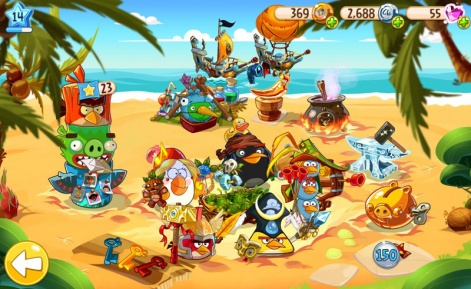
The Chimera team started the metamorphosis of 100 Heroes to the Angry Birds universe with two main questions in mind: What can the IP do for you? and What can you do for the IP?
With a strict Rovio policy of no real weapons and no death or real violence, part of Chimera's challenge was to create more than hundred weapons for the iconic birds which were, in essence, not weapons.
The end result had the executives at Rovio rolling on the floor with laughter, as Chuck was thoroughly equipped with a range of feathers, sponges and books while Matilda was gives various toys, combs and musical instruments to bring into battle.
The team started with two questions - What can the IP do for you? and What can you do for the IP?
Creative director at Chimera Entertainment, Alexander Kehr, worked on Angry Birds Epic from the earliest 100 Heroes pitch slides to the released game.
He says one of the major challenges he faced during the process was figuring out how to design a mid-core RPG game for a franchise known for their intuitive and super casual slingshot mechanic.
Could Chimera Entertainment nail the look? The humor? And most importantly - could they appeal to all the slingshot fans and make them enjoy playing an RPG?
Kehr says: "Working on one of the most famous IPs in casual gaming was exciting to say the least. We had to make sure the game would be enjoyable for casual and core gamers alike, without having to sacrifice game depth.
"The game may look deceptively simple at first glance, but the varied combat mechanics or class and equipment combos allow for a great deal of customization and tactics.
My favorite bird(s) are Jim, Jake & Jay (also known as "the Blues"), mainly because their headgears are so ridiculous and you get three birds for the price of one. Their classes are also really flexible and useful in most situations.
"I also like totally crazy team combos, like my favorite "Reflection Team" based on the Rogues or the "Multi-attack Mayhem Team", based around the Marksmen and other multi attack classes."
//Getting it right
Wanting to target both the core Angry Birds fan base, as well as seasoned RPG players, the team focused intensely on getting the game mechanics and balancing right, especially in the beginning of the game.
The dilemma was making it easy to learn for the casual players, all the while displaying - or at least hinting at - the depth of the game for the hardcore fans.
Project Lead Bernhard Falk singles this out as the team's biggest challenge: "You walk a thin line to make the game not too hard and not too easy. We noticed that concepts familiar to the experienced player, like turn-based combat, are not obvious to casual players, who were confused when they couldn't hide or protect themselves during the enemies' turn.
"So we tried to find a way to create a game complex enough to keep core players interested for a long period of time and at the same time accessible to the broad fan base of Angry Birds.
You walk a thin line to make the game not too hard and not too easy.Bernhard Falk
"For us it was a blast working with a successful and world famous brand. Adapting Angry Birds to a fantasy setting gave us the freedom to play with typical genre conventions in the funny style of the IP, and as a team of RPG fans we enjoyed this immensely. And Chuck remains my favorite bird - as every good RPG squad should feature a well-equipped mage."
Keeping it simple by using only two different stats; health and attack power, made it intuitive to attach the attack power to the birds' weapons, and health to their offhand items. Equipment is the main source to increase the stats of the birds, and a range of passive effects, such as stunning hammers, were added to spice things up.
Game designer Boris Conrad Heisserer says: "Designing the set items was quite challenging. They needed to be even more visually impressive than the regular equipment, and equally more powerful. So we came up with the unique set effects, which only kick in when the bird has equipped the full set. Furthermore; every set item fits visually to its counterpart.
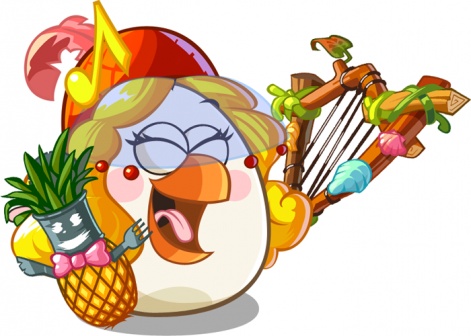
The initial balancing was a combination of experience and gut feeling. With an early version we performed user tests to check if the game mechanics and UI were intuitive for players.
"Using the results from these tests, the balancing went through further iterations until a quite polished version was accomplished for a three month soft launch phase in Canada, Australia and New Zealand. We had 14 different a/b test groups running simultaneously at the most."
//The creation of Piggy Island
Being true to the IP was crucial to the team, in both art and game design, and players can see this throughout the final product.
The game's soft currency is called "Snoutlings" - the cherries required for certain potions look unmistakably like pigs' snouts - and when zooming out on the map of Piggy Island, there is no doubt what the entire universe of Angry Birds Epic resembles.
First, the plan was to structure the game progress of Angry Birds Epic like the slingshot titles; through levels on a separate screen.
Then, the idea came to create Piggy Island, with different climate zones inhabited by unique pig enemies; for example mummies on Desert Island, ice knights on the snowy peaks of Crown Mountain and ninjas in the Bamboo Forest. Also, much of the equipment players can use is crafted from sea shells and flotsam found in the South Beach region.
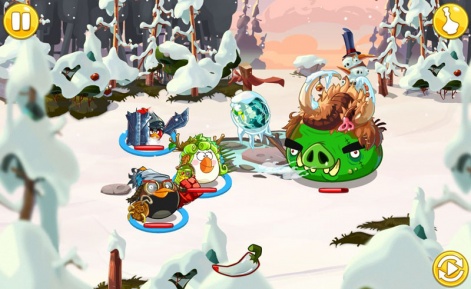
Rovio shared its concepts for Piggy Island with Chimera, and a model was digitalized via a 3D scan, which gave the developers a full overview of the island. There are currently 20 different regions on the map, in addition to the steadily increasing number of Chronicle Caves hiding in Hog Head Mountain.
Executive producer at Rovio, Anastasios Katopodis, says this about Chimera's approach to the Angry Birds IP: "The battle-difficulty gauge depicting a baby-pig with a pacifier for the easy side and the skull for the difficult one has been around since the beginning and is one of the details in the prototype that made a lot of people feel confident about how we could nail the right feel for an Angry Birds game. I find the baby pig with the pacifier hilarious.
"The game's soundtrack was made by Rovio, and it's my favorite one of all Angry Birds scores - I've been listening to it since I received the first rough versions. I am very proud that we got some guitar shredding bits in there as well!
"What people might not be aware of is that the composer of our music; Henri Sorvali at Rovio, is a heavy metal music musician/composer and producer who performs with bands such as Moonsorrow and Finntroll.
"It was super exciting to work on an RPG, which is one of my favorite game genres, with a core gameplay I loved since day one.
In Epic, there is an increased focus on the characters and they are presented in a much larger format on the screen.Markus Holzer
I equally loved the people I worked with, both at Chimera and internally at Rovio, since in addition to understanding each other perfectly throughout the development and being fantastic professionals, they were also people I enjoyed hanging out with."
//Characters and animation
The characters and animations were two of the most important aspects of Epic's visual presentation. While working on the prototype and replacing the heroes from Chimera's original game concept with the birds and pigs from Rovio, the team immediately realized that the iconic characters would only work in an RPG if given more elaborate movement and emotion.
Lead technical artist, Markus Holzer, was closely involved in the process of bringing the birds to life: "In the classic Angry Birds games characters consist of one single image which is replaced for each state.
"In Epic, there is an increased focus on the characters and they are presented in a much larger format on the screen. So we needed to split them up in their separate body parts - beaks, eyes, brows, etc. - to be able to animate each piece individually. We also decided not to use the classical look of the Angry Birds games, but to align the graphics closer to the more complex shading of the cartoon series.
"Using the plugin Smooth Moves for Unity 3D, we were able to set up a bone structure for each bird and pig and adjust each body part to its right place. Now we could move, rotate and scale the different pieces to achieve any behaviour and funny grimace we wanted.
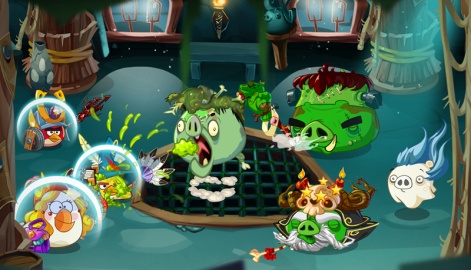
"Another important feature was the ability to swap any graphic at any given time. Therefore, we could easily replace a normal beak by a funny punched-in variant the moment a bird gets hit by a pig. By using these tools and great examples like Battlehearts and Rayman Origins, five birds and eighteen pig archetypes - each with a set of unique animations for movement, attacks and emotions - were brought to life."
//United by Unity
Angry Birds Epic is developed in Unity, and an improved infrastructure at Chimera allowed for simultaneous development for the three different mobile platforms the game was released for; Android, iOS and Windows Phone 8.
Andreas Katzig is CTO at Chimera and was the main driver of this process, which proved to be challenging - but in the end equally rewarding: "The improvement of our already existing multi-platform coding conventions were technically important to separate the distinct behaviors and API requirements for different platforms," he says.
"We strive for a mix of the KISS-principle ("keep it simple, stupid") and well-known software architecture design patterns to glue all components together. These conventions were also socially important to shield gameplay programmers from infrastructure implementations they didn't want to cope with.
"I require high standards for the automated build pipeline, which always guarantees fresh builds with consistent configuration settings.
Giving birth to something completely new in an already existing franchise is an awesome experience.Andreas Katzig
"This pipeline not only consists of compiling the project, but also generating binary balancing data out of for example Excel sheets and other asset data management tools. The pipeline also enables us to automatically distribute test builds to all devices of different platforms involved, and upload generated balancing data to our servers. This level of automation saved us an impressive amount of manual labor, and was an important piece of the puzzle which allowed the development of Epic with a relatively small team in an equally short amount of time.
"Giving birth to something completely new in an already existing franchise is an awesome experience. The whole production was - and still is - exciting to me. It is amazing having experienced the evolution of the Angry Birds Epic characters first drawn on paper in 2012, getting the deal signed, and seeing our characters, world and technology now enriching the Angry Birds universe.
"The collaboration with Rovio was unbelievably smooth, and I've learned a lot from the collaboration and the people involved. The level of insight I got on how to operate a mobile game on a very, very big scale is invaluable.
"Bomb is definitely my favorite bird. Because he's big and can be incredibly powerful. Plus, I can totally understand that he enjoys exploding."
//Unleashing the birds
After months of development, A/B testing, bug fixing and final polishing, Angry Birds Epic was finally ready to go live worldwide on 12 June 2014.
Well received by critics and players alike, the servers were filling up faster than anyone expected. CEO of Remote Control Productions and Executive Producer on Angry Birds Epic, Hendrik Lesser, was delighted to see how well the team rose to the challenge, and executed well under the ever present premise; the game could get cancelled until the very last minute.

Lesser says: "I'm proud we never had to ask the team to crunch, that they not only developed the game from concept to launch, but in collaboration with Rovio pushed the Angry Birds IP even further.
"I can honestly say we never had a frustrating moment; the project was very challenging, but we were in the flow, and I think it shows in the final game. The fans love it, and we've managed to give a new generation of gamers an introduction to RPGs. That in itself makes the game relevant".
Lead Programmer Maximilian Dienersberger says this of his experience at launch: "The global release was incredibly challenging, because as a developer you suddenly realize that millions of people will start playing the game simultaneously, skyrocketing both player feedback and bug reports compared to the more modest push of soft launch.
"Still it was good to see that with the soft launch we had gotten rid of the most infrastructure dependent bugs - and that players were having fun.
"My favorite bird is Red. Because he is the defender, an honorable protector of his weaker allies and therefore the true hero."
//Life after launch
Today, Rovio and Chimera are still expanding the game.
An event collaboration with GungHo's popular Puzzle & Dragons took place in October, and a PvP update hit Piggy Island right in time for Christmas.
Chimera's Managing Director, Christian Kluckner, is proud of the journey the project has made from the humble beginnings of 100 Heroes: "When we first came up with the idea for 100 Heroes, it was a game everyone at Chimera wanted to make.
"We did not have any birds in mind back then, but we are huge RPG fans, and in the end hit the jackpot when combining the Angry Birds IP with our own gameplay ideas.
"Not only have we been able to deliver a fun gaming experience, but we also learned a lot and made a bunch of great new friends at Rovio."
For those of you who didn't have a chance to play Angry Birds Epic yet: head into battle!

